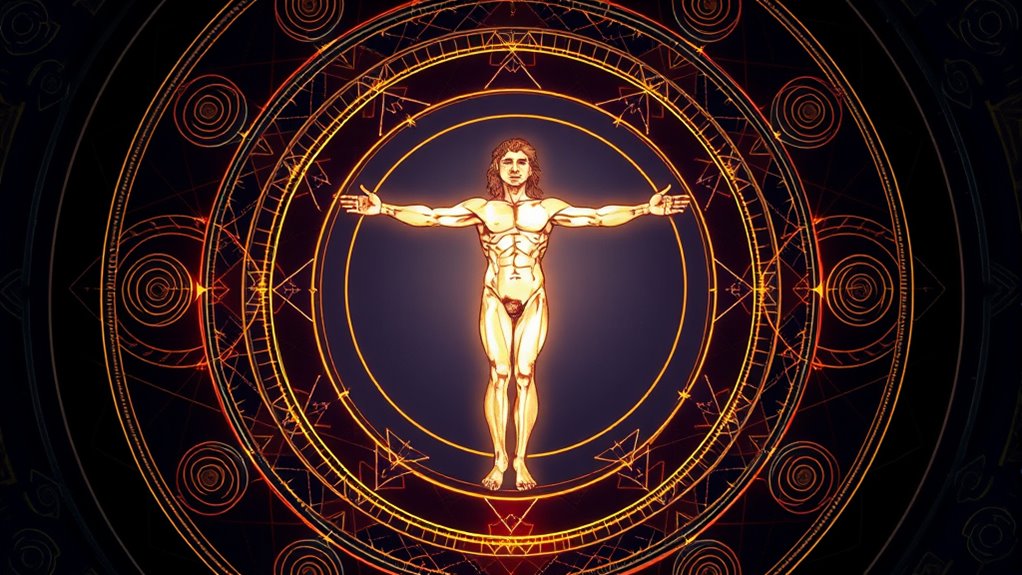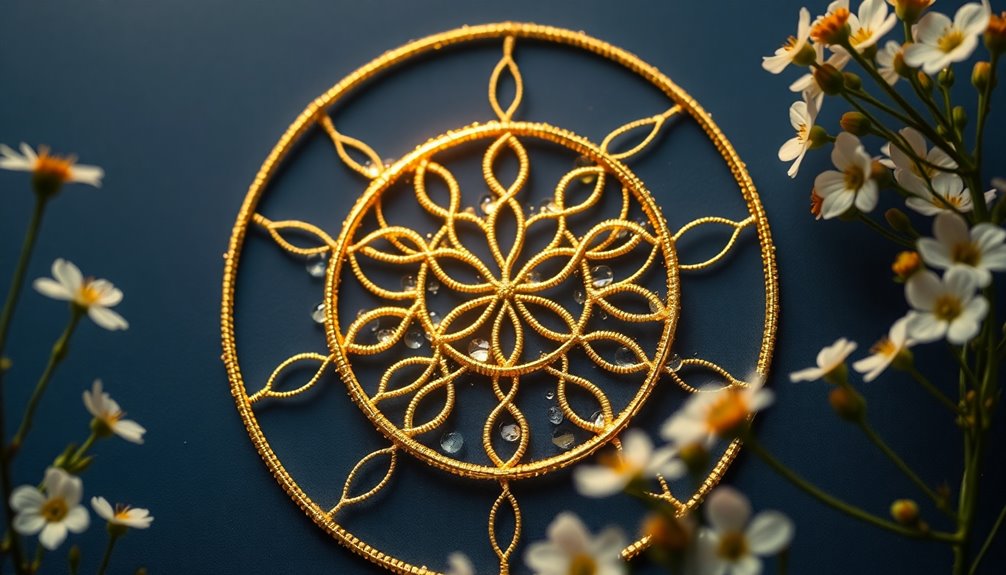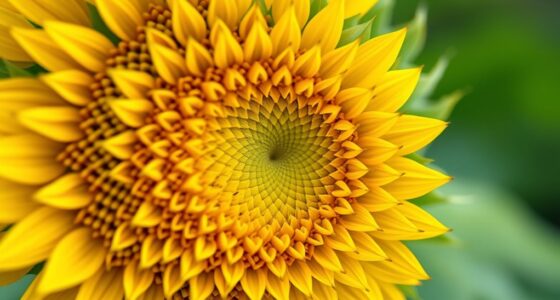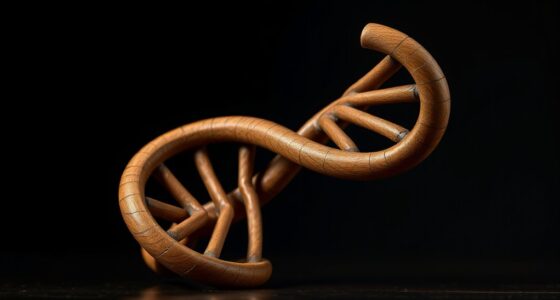Sacred geometry forms the foundation of the Vitruvian Man, showing how human proportions embody divine patterns and ratios like the Golden Ratio. Leonardo da Vinci’s drawing highlights the harmony between the human body and geometric shapes, revealing that our form echoes universal order. These ratios aren’t random but reflect a deeper interconnectedness of all things. If you explore further, you’ll discover how this ancient wisdom links us to the cosmos and spiritual truths.
Key Takeaways
- The Vitruvian Man visually exemplifies the principles of sacred geometry through perfect proportions and geometric shapes like circles and squares.
- It demonstrates how human proportions embody divine ratios, particularly the Golden Ratio, reflecting universal harmony.
- Leonardo da Vinci’s drawing illustrates the interconnectedness of the human body with natural and cosmic geometric patterns.
- The image acts as a symbolic blueprint linking physical human form to spiritual and universal order via sacred geometry.
- Sacred geometry in the Vitruvian Man emphasizes the idea that human proportions mirror the divine structure of the universe.

Sacred geometry has long been considered the blueprint of the universe, reflecting the divine order embedded in nature. At its core, it reveals universal patterns that repeat across scales, from galaxies to tiny cells. These patterns aren’t random; they follow precise ratios known as divine proportions, which seem to govern the harmony and balance of all living and non-living systems. When you explore these concepts, you begin to see how the intricate design of the universe is woven into the fabric of everything around you. The idea is that these sacred ratios, especially the golden ratio, are embedded in the very structure of reality, serving as a bridge between the physical and spiritual worlds. You can observe divine proportions in the spirals of shells, the branching of trees, and even in the proportions of the human body. This is where the Vitruvian Man comes into focus—a famous drawing by Leonardo da Vinci that embodies these principles. It depicts a man with outstretched arms and legs inscribed within a circle and square, showcasing the perfect harmony between the human form and the fundamental geometric shapes. What makes this image powerful is that it visually demonstrates how human proportions align with universal patterns. You can think of the Vitruvian Man as a living blueprint, an expression of how divine proportions manifest in the human body. Leonardo’s work reflects an understanding that the proportions of the body aren’t arbitrary but follow precise mathematical ratios that echo the divine order found in nature. When you study the drawing, you realize that the human form is a microcosm of the universe, embodying a harmony that extends beyond individual anatomy. These divine proportions are not just aesthetic; they carry spiritual significance, symbolizing the interconnectedness of all things. Recognizing these patterns can deepen your appreciation for the natural world and your place within it. It’s as if the universe has encoded its secrets in the geometry of the human body itself, waiting for you to decipher its message. The Vitruvian Man exemplifies this harmony, acting as a visual reminder that everything in existence follows a sacred design. By understanding these universal patterns and divine proportions, you gain insight into the underlying order of the cosmos, helping you see yourself as part of a larger, interconnected universe. Sacred geometry isn’t just about shapes and ratios; it’s about recognizing the divine intelligence that underpins the structure of reality, inviting you to experience a deeper sense of unity and purpose. Additionally, universal patterns in nature reinforce the idea that these proportions are fundamental to understanding the interconnectedness of all life.
Frequently Asked Questions
How Does Sacred Geometry Influence Modern Architectural Design?
Sacred geometry influences modern architectural design by guiding you to create spaces with geometric harmony and proportional aesthetics. You use these principles to guarantee structures are visually balanced and harmonious, appealing to the human eye. Incorporating sacred geometry helps you craft buildings that feel naturally pleasing, fostering a sense of order and beauty. This approach elevates your designs, making them not only functional but also spiritually and aesthetically resonant.
Are There Other Famous Artworks Based on Sacred Geometry Principles?
You see the mesmerizing Fibonacci spiral and Golden ratio echoing through iconic artworks like Leonardo da Vinci’s “Mona Lisa” and the Parthenon’s columns. These masterpieces harness sacred geometry’s beauty, creating harmony and balance that captivate your eye. The spirals seem to dance, drawing you into a world where mathematical precision and artistic expression intertwine, revealing timeless secrets of nature and aesthetics woven into cultural treasures.
What Are the Mathematical Ratios Used in the Vitruvian Man?
You’ll find that the Vitruvian Man uses key mathematical ratios like the Golden Ratio to achieve Proportional Harmony. Leonardo da Vinci applied these ratios to the human body, especially in the head, limbs, and torso, ensuring balanced proportions. These ratios help create a sense of aesthetic perfection, reflecting the natural harmony found in nature and human anatomy, making the artwork a timeless symbol of geometric precision.
How Does Sacred Geometry Relate to Spiritual or Mystical Beliefs?
Sacred geometry relates to spiritual and mystical beliefs through its symbolic significance, representing the fundamental patterns of creation. You might see these geometric symbols as embodying divine principles, connecting the physical and spiritual worlds. Many believe that understanding these patterns enhances spiritual awareness, serving as tools for meditation and enlightenment. By exploring sacred geometry, you tap into deeper spiritual symbolism that reveals the universe’s hidden harmony and divine order.
Can Sacred Geometry Be Applied to Personal Development or Healing?
Did you know that 85% of people report feeling more balanced after incorporating energy healing into their routines? Sacred geometry can be applied to personal development or healing by enhancing your mindfulness meditation practices. It helps you connect with the natural patterns of the universe, fostering inner harmony. By visualizing geometric shapes, you can amplify energy flow, making your healing journey more effective and empowering your growth.
Conclusion
As you explore sacred geometry and the Vitruvian Man, you realize how deeply interconnected our bodies are with universal patterns. These timeless designs remind you that everything is part of a bigger picture, like pieces of a puzzle fitting perfectly. Embracing this knowledge, you see that understanding our place in the universe isn’t just a lofty ideal—it’s right there in front of you. Sometimes, you just have to look beyond the surface to find the beauty that’s been waiting to be uncovered.










